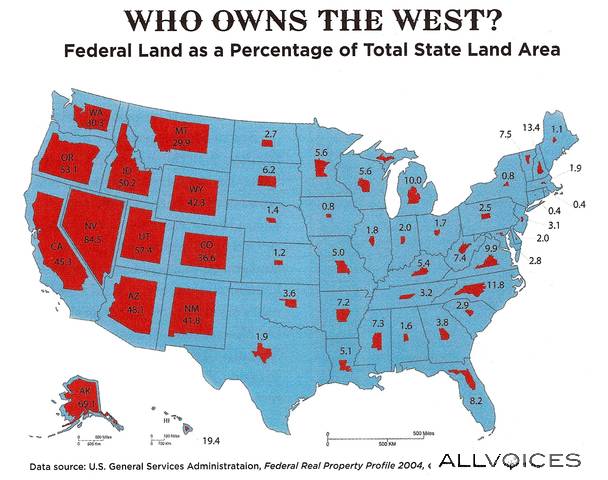
Posted on 05/30/2012 10:04:44 AM PDT by NevadaPolicyResearchInstitute
Derek Yonai, an economics professor at Campbell University, had a great op-ed in Sunday's Las Vegas Review-Journal on how freeing Nevada's lands from federal control would increase economic growth in our state.
The federal government owns approximately 85 percent of Nevada's land, preventing the state from developing those lands to improve its economy and allow for job creation.Read the whole thing here.With just 15 percent of the state left to its people for potential private development, Nevadans are restrained in realizing their entrepreneurial potential. Making due with only 15 percent of one's resources would hinder anyone. Who can flourish on 15 percent of their present assets? ...
All of this federally owned land is "dead property," meaning it is not available for development and its value is not being realized.
To get a sense of how much "dead property" there is in Nevada, consider this picture.
(Excerpt) Read more at writeonnevada.com ...
” The federal government owns approximately 85 percent of Nevada’s land, preventing the state from developing those lands to improve its economy and allow for job creation. “
85%......and this is a free country?
I’ll bet few Americans outside of Nevada know this.

The lands west of Mississippi were gained by conquest (war with Mexico) or by purchase. Under the homesteading system, folks would perfect their claim to surveyed land (called “public land” as opposed to unsurveyed “public domain land”) by acts of discovery, possession, continuous beneficial use set forth in the homestead acts. Once that claim was perfected, a land patent or evidence of original title could be issued by the federal land office. Then in the late 1890s- early 1900s, the federal government began to “withdraw” forest land from the action of the homestead acts. Supposedly, this was to ensure a constinous supply of lumber for the American public and continuous flows of water for downriver communities. These “Forest Reserves” became the National Forests.
Since the homestead acts were geared to farming operations that suited the size of farms in the wet east coast, ranchers in the arid west had to expand their grazing operations onto the public lands. They secured state water rights for the lands, rights of way over the land and a right to associated forage. Because the water rights were already appropriated, homesteads were not claimed in many areas. “Public lands” left over from homesteading in the west were claimed under FLPMA in 1976 as belonging to the federal government (BLM.)
The federal government likes to cite enabling acts as acquiesence by the new states that the federal government can keep the land it stole from the people of the western states. However, there have been several SCOTUS opinions that enabling act provisions such as this are not binding on the new state legislature. (The only exception would be Alaskan lands actually physically excluded from statehood and kept in federal ownership and certain tribal treaty lands, which were excluded from the action of statehood.
Others frequently cite Article IV Section 3 Clause 2 of the Constitution. However, looking back to the date of the document, the lands west of the Mississippi did not exist as part of the United States at this time. The clause applied only to the “western wastelands” east of the Mississippi which had been given by deeds of cession from the colony/states to the federal government to sell to settle mutual war debt.
Until the federal lands of the west are returned to the people of those states and the combined federal government of all the states cease to control large areas of land in the west, the western states will never be equal with the eastern states.
GIVE US OUR LAND BACK! (Petition to return public lands to local government)http://giveusourlandback.org/
Day late and dollar short bump.
Disclaimer: Opinions posted on Free Republic are those of the individual posters and do not necessarily represent the opinion of Free Republic or its management. All materials posted herein are protected by copyright law and the exemption for fair use of copyrighted works.